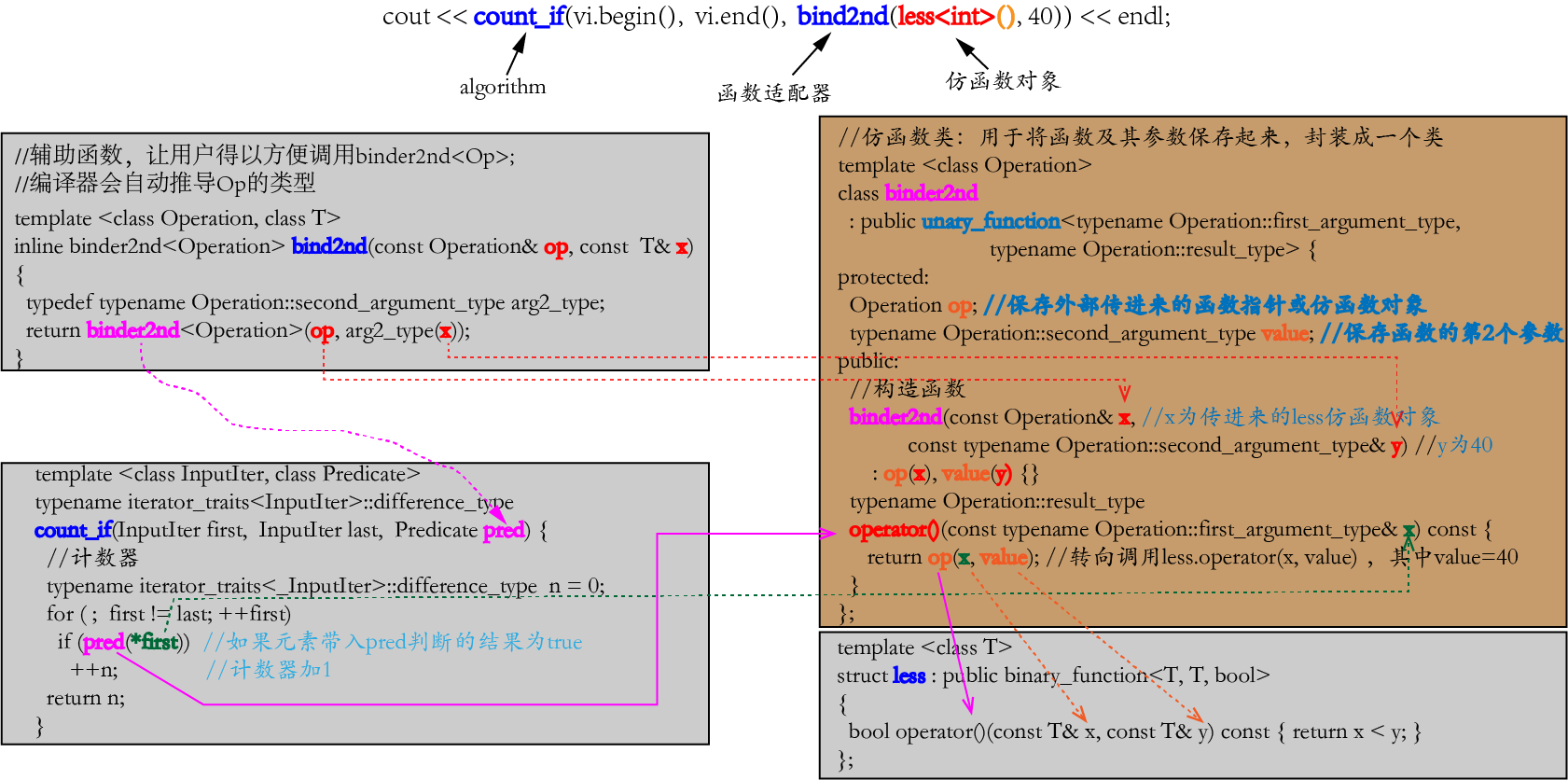1. 几种可调用对象(Callable Objects)
(1)普通函数指针或类成员的函数指针
(2)具有operator()成员函数的类对象(仿函数)。如c++11中的std::function类模板,本质上就是一个仿函数。
(3)可被转换为函数指针的类对象(需要重载类型转换操作符operator type(),其中type为目标类型:函数指针。这种写法与不带参的type operator()(void)效果等价)。
【编程实验】可调用对象示例
//test1.cpp
#include <iostream> using namespace std; //1. 普通函数 void func(void) { } //2. 仿函数对象 struct Foo { void operator()(void) { } }; //3. 可转换为函数指针的类 struct Bar { using fr_t = void(*)(void); //function return type: 函数返回值类型 static void func(void) { } //将类对象转化为函数指针。 //(本质上还是仿函数,只不过返回值是函数指针(fr_t)。 operator fr_t(void) //重载类型转换操作符,效果上等价于fr_t operator()(void) { return func; } }; //4. 类的成员函数 struct Test { int m; void mem_func(void) { } }; int main() { //1. 普通函数 void(*pfunc)(void) = &func; pfunc(); //2.仿函数 Foo foo; foo(); //3.可转换为函数指针的类 Bar bar; bar(); //4.类成员函数指针 void(Test::*pmem_func)(void) = &Test::mem_func; int Test::*pm = &Test::m; Test t; (t.*pmem_func)(); t.*pm = 123; return 0; }
2. 仿函数类的分析(如: binder2nd<T>、less<T>)
(1)以count_if算法的调用为例

①调用count_if函数时,要向其传入容器的相关迭代器以及第3个参数,该参数是一个判断表达式,在本例中是一个binder2nd类型的仿函数对象。
②每次遍历时,会调用binder2nd仿函数对象的operator(),并向其传入(*first)参数。该对象内部保存着由外部传入的less仿函数对象的引用及该函数对象的第2个参数值40,它们分别保存在op变量和value变量中。
③在binder2nd仿函数对象的operator()中,会调用op仿函数 (less对象)并传入*first和40,从而可以判断*first和40的大小。
(2)相关源代码以说明

/***********************************************************************/ //以下两个类模板主要用于定义函数参数和返回值的类型。让子类可以回答 //函数适配器(adapter)可能向其询问的这两个问题。 //只有一个参数的函数类模板 template <class Arg, class Result> struct unary_function { typedef Arg argument_type; //参数类型 typedef Result result_type; //返回值类型 }; //两个参数的函数类模板 template <class Arg1, class Arg2, class Result> struct binary_function { typedef Arg1 first_argument_type; //第1个参数类型 typedef Arg2 second_argument_type; //第2个参数类型 typedef Result result_type; //返回值类型 }; /***********************************************************************/ //统计指定范围的元素个数的算法 template <class InputIter, class Predicate> typename iterator_traits<InputIter>::difference_type count_if(InputIter first, InputIter last, Predicate pred) { typename iterator_traits<InputIter>::difference_type n = 0; //计数器 for ( ; first != last; ++first) if (pred(*first)) //如果元素带入pred判断的结果为true,计数器加1 ++n; return n; } /***********************************************************************/ //仿函数对象:用于比较x和y的大小。x<y则返回真,否则假。 //注意:该类继承自binary_function类,表达他有两个参数和一个返回值。 template <class T> struct less : public binary_function<T, T, bool> { bool operator()(const Tp& x, const T& y) const { return x < y; } }; //仿函数类:用于将可调用对象(如函数)以及其参数保存并封装成一个类 //注意:该类继承自unary_function类,表示只有一个参数和返回值。 // binder2nd顾名思义就是要将参数绑定在op的第2个参数上,所以要求 // Operation这个类必须继承自binary_function。 template <class Operation> class binder2nd : public unary_function<typename Operation::first_argument_type, typename Operation::result_type> { protected: Operation op; //可调用对象(如函数) //Operation类必须继承自binary_function类,才能回答下列关于第2个参数类型的提问。 typename Operation::second_argument_type value;//函数的第2个参数 public: //构造函数 binder2nd(const Operation& x, const typename Operation::second_argument_type& y) : op(x), value(y) {} typename Operation::result_type operator()(const typename Operation::first_argument_type& x) const { return op(x, value); //转向调用被保存对象的operator()函数 } }; /***********************************************************************/ //辅助函数,让用户间接地,当然也更方便调用binder2nd(op,x); //如果直接调用,如binder2nd<Operation>(less<int>(), 40)则还需要填写出Operation,根据 //binder2nd模板的定义,该值就是op的类型,此例中即less<int>的类型,这不好判断。 //而如果用以下的bind2nd函数,可以让编译器根据op(即less<int>)自动推导出Operation类型。 template <class Operation, class T> inline binder2nd<Operation> bind2nd(const Operation& op, const T& x) { typedef typename Operation::second_argument_type arg2_type; return binder2nd<Operation>(op, arg2_type(x)); }
3. binder2nd类模板和bind2nd函数模板(重点)
(1)binder2nd类模板
①重载了operator()操作符,所以该类的对象是一个函数对象(仿函数)
②该类用于保存外部传入的函数(或仿函数)以及其参数。它是一个Wrapper类,用于包装和改造传入的函数(或仿函数),然后形成一个新的仿函数对象。
③继承自unary_function模板,表示该类最终绑定外部函数及参数后,仍然是一个函数对象(仿函数)。但新函数对象与传入的函数相比,其参数个数减少为1个。
(2)bind2nd函数模板
①bind2nd是一个函数模板,用于简化对binder2nd的操作。
②函数的返回值是一个binder2nd对象,该对象是个函数对象(仿函数),也是一个可调用对象。
(3)bind1st、bind2nd函数模板
①bind1st用于将参数绑定在被绑定函数的第1个参数上,返回新的函数对象。
②bind2nd用于将参数绑定在被绑定函数的第2个参数上,返回新的函数对象。
